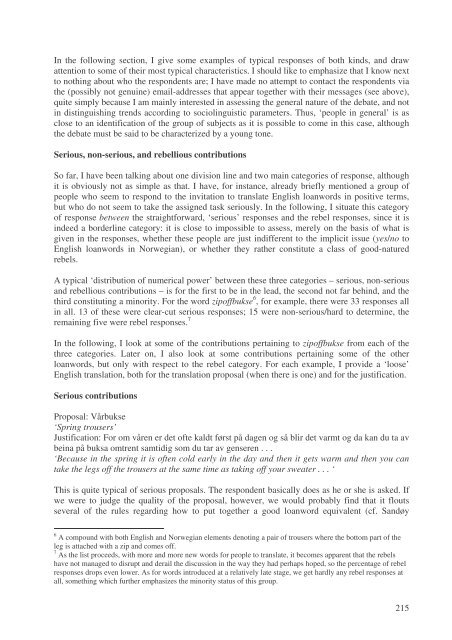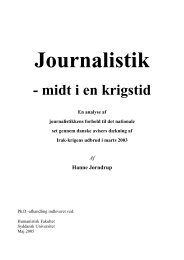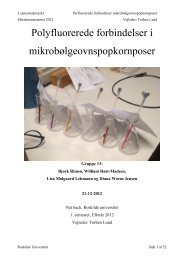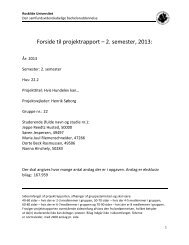Attitudes to English loanwords in Norwegian
Attitudes to English loanwords in Norwegian
Attitudes to English loanwords in Norwegian
Create successful ePaper yourself
Turn your PDF publications into a flip-book with our unique Google optimized e-Paper software.
In the follow<strong>in</strong>g section, I give some examples of typical responses of both k<strong>in</strong>ds, and drawattention <strong>to</strong> some of their most typical characteristics. I should like <strong>to</strong> emphasize that I know next<strong>to</strong> noth<strong>in</strong>g about who the respondents are; I have made no attempt <strong>to</strong> contact the respondents viathe (possibly not genu<strong>in</strong>e) email-addresses that appear <strong>to</strong>gether with their messages (see above),quite simply because I am ma<strong>in</strong>ly <strong>in</strong>terested <strong>in</strong> assess<strong>in</strong>g the general nature of the debate, and not<strong>in</strong> dist<strong>in</strong>guish<strong>in</strong>g trends accord<strong>in</strong>g <strong>to</strong> sociol<strong>in</strong>guistic parameters. Thus, ‘people <strong>in</strong> general’ is asclose <strong>to</strong> an identification of the group of subjects as it is possible <strong>to</strong> come <strong>in</strong> this case, althoughthe debate must be said <strong>to</strong> be characterized by a young <strong>to</strong>ne.Serious, non-serious, and rebellious contributionsSo far, I have been talk<strong>in</strong>g about one division l<strong>in</strong>e and two ma<strong>in</strong> categories of response, althoughit is obviously not as simple as that. I have, for <strong>in</strong>stance, already briefly mentioned a group ofpeople who seem <strong>to</strong> respond <strong>to</strong> the <strong>in</strong>vitation <strong>to</strong> translate <strong>English</strong> <strong>loanwords</strong> <strong>in</strong> positive terms,but who do not seem <strong>to</strong> take the assigned task seriously. In the follow<strong>in</strong>g, I situate this categoryof response between the straightforward, ‘serious’ responses and the rebel responses, s<strong>in</strong>ce it is<strong>in</strong>deed a borderl<strong>in</strong>e category: it is close <strong>to</strong> impossible <strong>to</strong> assess, merely on the basis of what isgiven <strong>in</strong> the responses, whether these people are just <strong>in</strong>different <strong>to</strong> the implicit issue (yes/no <strong>to</strong><strong>English</strong> <strong>loanwords</strong> <strong>in</strong> <strong>Norwegian</strong>), or whether they rather constitute a class of good-naturedrebels.A typical ‘distribution of numerical power’ between these three categories – serious, non-seriousand rebellious contributions – is for the first <strong>to</strong> be <strong>in</strong> the lead, the second not far beh<strong>in</strong>d, and thethird constitut<strong>in</strong>g a m<strong>in</strong>ority. For the word zipoffbukse 6 , for example, there were 33 responses all<strong>in</strong> all. 13 of these were clear-cut serious responses; 15 were non-serious/hard <strong>to</strong> determ<strong>in</strong>e, therema<strong>in</strong><strong>in</strong>g five were rebel responses. 7In the follow<strong>in</strong>g, I look at some of the contributions perta<strong>in</strong><strong>in</strong>g <strong>to</strong> zipoffbukse from each of thethree categories. Later on, I also look at some contributions perta<strong>in</strong><strong>in</strong>g some of the other<strong>loanwords</strong>, but only with respect <strong>to</strong> the rebel category. For each example, I provide a ‘loose’<strong>English</strong> translation, both for the translation proposal (when there is one) and for the justification.Serious contributionsProposal: Vårbukse‘Spr<strong>in</strong>g trousers’Justification: For om våren er det ofte kaldt først på dagen og så blir det varmt og da kan du ta avbe<strong>in</strong>a på buksa omtrent samtidig som du tar av genseren . . .‘Because <strong>in</strong> the spr<strong>in</strong>g it is often cold early <strong>in</strong> the day and then it gets warm and then you cantake the legs off the trousers at the same time as tak<strong>in</strong>g off your sweater . . . ‘This is quite typical of serious proposals. The respondent basically does as he or she is asked. Ifwe were <strong>to</strong> judge the quality of the proposal, however, we would probably f<strong>in</strong>d that it floutsseveral of the rules regard<strong>in</strong>g how <strong>to</strong> put <strong>to</strong>gether a good loanword equivalent (cf. Sandøy6 A compound with both <strong>English</strong> and <strong>Norwegian</strong> elements denot<strong>in</strong>g a pair of trousers where the bot<strong>to</strong>m part of theleg is attached with a zip and comes off.7 As the list proceeds, with more and more new words for people <strong>to</strong> translate, it becomes apparent that the rebelshave not managed <strong>to</strong> disrupt and derail the discussion <strong>in</strong> the way they had perhaps hoped, so the percentage of rebelresponses drops even lower. As for words <strong>in</strong>troduced at a relatively late stage, we get hardly any rebel responses atall, someth<strong>in</strong>g which further emphasizes the m<strong>in</strong>ority status of this group.215
















